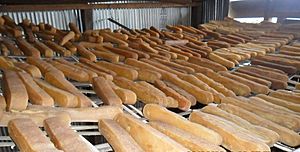Chhurpi facts for kids
Quick facts for kids Chhurpi |
|
|---|---|

Production of Chhurpi in Nepal
|
|
| Other names | Durkha |
| Country of origin | Tibet |
| Region | Tibet |
| Source of milk | Yak, Cattle |
| Texture | Soft or hard |
| Named after | Lua error in Module:Wikidata at line 70: attempt to index field 'wikibase' (a nil value). |
Chhurpi (Tibetan: ཆུར་བ།, THL: churwa) or durkha is a traditional cheese eaten in Tibet and other Himalayan regions. It comes in two main types: a soft kind and a hard kind. The soft chhurpi is often eaten with rice, while the hard chhurpi is chewed like a gum.
Contents
How Chhurpi Is Made
Chhurpi is usually made in local dairies or at home from buttermilk. Here's how it's done:
- The buttermilk is boiled.
- A solid, cheese-like mass forms and separates from the liquid.
- This solid part is then wrapped in a thin cloth and hung up. This helps drain out all the extra water.
- The result is a soft, white cheese that tastes quite plain. It's a bit like ricotta cheese.
- Sometimes, it's left to ferment a little longer. This gives it a tangy, slightly sour taste.
Making Hard Chhurpi
To make the hard version of chhurpi, the soft cheese goes through a few more steps:
- The soft chhurpi is put into a jute bag.
- It's then pressed very hard to squeeze out even more water.
- After it dries, it's cut into small, cube-shaped pieces.
- These pieces are hung over a fire. This makes them even harder and helps them last a long time.
Chhurpi is a very important food in the hilly areas of India, Nepal, and Bhutan. It's made using a special process called lactic fermentation, which uses helpful bacteria. This cheese is popular among many different groups of people living in the Himalayan region, including places like Arunachal Pradesh, Darjeeling, and Sikkim.
Soft vs. Hard Chhurpi
Chhurpi is generally divided into two types:
- Soft Chhurpi: This type is meant to be eaten right away.
- Hard Chhurpi: This type is made to be stored and eaten later. People often chew it for extra energy.
The way chhurpi is made can be a little different depending on the exact place in the Himalayan region. For example, in some parts of Nepal, chhurpi is made from Yak milk. In Ladakh, it's made from the milk of a Dzomo, which is a mix of a cow and a yak. People in these areas eat chhurpi with their meals, meat, vegetables, and soups. It adds flavor and also provides good nutrition.
How Chhurpi Is Eaten
Soft chhurpi can be enjoyed in many ways:
- It's cooked with green vegetables to make tasty dishes.
- It's used as a filling for momo, which are a type of dumpling.
- It can be ground up with tomatoes and chilies to make a senpen (a kind of chutney).
- It's also used to make soups.
In the mountains of Tibet, chhurpi is a great source of protein. It's often eaten instead of vegetables because it's so nutritious.
Hard chhurpi is usually eaten by putting a piece in your mouth. You let it get soft from your saliva, and then you chew it like a piece of gum. One piece of hard chhurpi can last for up to two hours! Because it's high in protein and has a tangy taste, hard chhurpi has also become a popular treat for dogs in Western countries.
See also
 In Spanish: Chhurpi para niños
In Spanish: Chhurpi para niños

